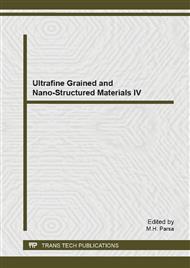p.515
p.520
p.525
p.530
p.534
p.539
p.544
p.549
p.554
Preparation of Cellulose Nanofibrils by High-Pressure Homogenizer and Zein Composite Films
Abstract:
Cellulose nanofibrils ( NF ) have several advantages such as biodegradability and safety toward human health. Zein is a biodegradable polymer with potential use in food packaging applications. It appears that polymer nanocomposites are one of the most promising applications of zein films. Cellulose NF were prepared from starting material Microcrystalline cellulose (MCC) by an application of a high-pressure homogenizer at 20,000 psi and treatment consisting of 15 passes. Methods such as atomic force microscopy were used for confirmation of nanoscale size production of cellulose. The average diameter 45 nm were observed. Zeincellulose NF nanocomposite films were prepared by casting ethanol suspensions of Zein with different amounts of cellulose NF in the 0% to 5%wt. The nanocomposites were characterized by using Fourier transform infrared spectroscopy ( FTIR ), Atomic force microscopy ( AFM ) and X-ray diffraction ( XRD ) analysis. From the FTIR spectra the various groups present in the Zein blend were monitored. The homogeneity, morphology and crystallinity of the blends were ascertained from the AFM and XRD data, respectively. The thermal resistant of the zein nanocomposite films improved as the nanocellulose content increased. These obtained materials are transparent, flexible and present significantly better physical properties than the corresponding unfilled Zein films.
Info:
Periodical:
Pages:
534-538
Citation:
Online since:
November 2013
Authors:
Keywords:
Price:
Сopyright:
© 2014 Trans Tech Publications Ltd. All Rights Reserved
Share:
Citation:


